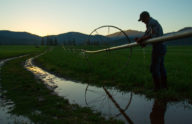Running down the controlling opinion in Rapanos v. United States

In February of this year, the President signed an Executive Order calling for the Army Corps of Engineers and EPA to review and revise the government’s ill-fated Rapanos v United States definition of “waters of the United States” published in June, 2015. That definition sets the limits of federal authority under the Clean Water Act and literally affects millions of landowners nationwide. The 2015 WOTUS Rue (as it is commonly called), was unprecedented in scope asserting federal power to regulate virtually all waters in the Country and much of the land in direct conflict with the Clean Water Act and the Constitution of the United States. The rule was assailed by more than 30 states and scores of industry groups and landowners, including those represented by PLF. The rule was immediately stayed when two courts ruled it was likely invalid. But before the Sixth Circuit Court of Appeals could issue a final decision on the rule’s validity, the President issued his Executive Order. This had the effect of putting the pending litigation on hold, until the Corps and EPA can issue a new rule. According to the Executive Order, the new rule must satisfy two criteria: (1) the rule must accord with national policy to protect national waters without undermining the economy or statutory and constitutional law; and (2), the rule must be revised with due consideration for the opinion authored by Justice Scalia in PLF’s 2006 U.S. Supreme Court Rapanos decision which set the outer limits of federal authority under the Clean Water Act.
The Courts of Appeals and some legal scholars disagree on which opinion in the Rapanos case is controlling and should be followed by the federal agencies and the lower federal courts. Justice Scalia authored an opinion (joined by three other Justices) that gave a rather narrow interpretation of federal authority under the Act while Justice Kennedy (in a lone concurring opinion) gave a much broader interpretation of federal authority under the Act. Determining which opinion is controlling and how it should be implemented is complicated by the fact that the 2015 WOTUS rule far exceeds either of these opinions. Therefore, revision of that rule is not only prudent, but necessary to restore the rule-of-law..
We believe the Scalia opinion is controlling and should form the basis for a new rule defining “waters of the United States.” I authored an article defending this position called Running Down the Controlling Opinion in Rapanos v. United States. The article will be published in the fall edition of the University of Denver Water Law Journal. This is the abstract:
In Rapanos v United States, a majority on the Supreme Court held the federal government could not regulate all “waters of the United States” under the Clean Water Act based on a mere hydrological connection to a traditional navigable waterway. But the Court split 4-1-4 as to the jurisdictional test for covered waters. The four-member Scalia plurality would authorize federal regulation of only those wetlands physically abutting and indistinguishable from natural rivers, lakes, and streams connected to a traditional navigable waterway. Justice Kennedy concurred in the judgment but proffered a different test that would allow federal regulation of any wetland with a “significant nexus” to a traditional navigable water, even in the absence of a direct hydrological connection. The four Justices in the dissent would authorize federal regulation of all waters that would serve to protect the nation’s waters generally. Therefore, the lower courts must decide the controlling opinion. The only standard provided by the Supreme Court to interpret its split decisions is set forth in Marks v. United States. Under Marks, the controlling opinion is that position “taken by those Members who concurred in the judgments on the narrowest grounds.” The term “narrowest grounds” means that opinion which is a logical subset of the other concurring opinion(s) in the case. The circuit courts are divided on how to apply Marks to the Rapanos decision. Some have adopted the lone Kennedy concurrence or rejected Marks as unworkable allowing the government to establish federal jurisdiction under either the Kennedy concurrence or the Scalia plurality. In each case, the court either misconstrued Marks or misinterpreted Rapanos. This article makes the case that whenever the Scalia plurality would find a jurisdictional water, Justice Kennedy would agree because the plurality test is a logical subset of Justice Kennedy’s broader “significant nexus” test. Together, the four Justices in the plurality and Justice Kennedy constitute a five-member majority. Under a proper application of Marks, the Scalia plurality is the controlling opinion in the Rapanos decision.
With a free registration, this article may be downloaded and read in prepublication form at SSRN.com here.


